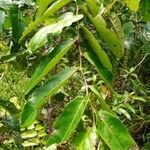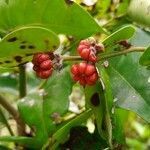Shrubs or treelets, 1-6 m tall, monoecious, glabrous throughout. Stipules triangular, persistent; petioles 5-8 mm; leaf blade oblong, ovate-oblong, or ovate, sometimes oblong-elliptic, 6-18 × 4-8 cm, leathery, base cordate, subcordate, truncate, or rounded, slightly oblique; lateral veins 5-7 pairs. Flowers in axillary clusters or in short, supra-axillary, pedunculate cymes, usually female flowers inserted at upper part of branchlets, male flowers inserted at lower part of branchlets, or female inflorescence with 1-3 flowers. Male flowers: pedicels 6-9 mm; sepals 5 or 6, connate into a column. Female flowers: sepals as in male; ovary globose, 5-or 6-locular; styles very short, connate into a very brief column. Capsules depressed globose, 8-10 × ca. 5 mm, 8-12-grooved. Seeds hemispheric, red. Fl. Mar-Aug, fr. Jul-Nov.
More
A shrub or small tree. It grows 1-6 m tall. The leaves are oval and 6-18 cm long by 4-8 cm wide. They are leathery. The flowers are in small branched groups The male flowers are in the lower part and female flowers higher up. The flowers are in the axils of leaves and are yellowish-green. The fruit is a capsule 8-10 mm long by 5 mm wide. There are 8-12 lobes. The seeds are red and half round.
Humid valleys, scrub on streambanks; at elevations from 100-600 metres. Favoured by disturbance, it is found in a variety of habitats, from well developed rain forest to fringing forest along creeks through eucalypt forest.
More
It is a tropical plant. It grows in mountains and on the edge of forests. It grows between 100-600 m above sea level.



